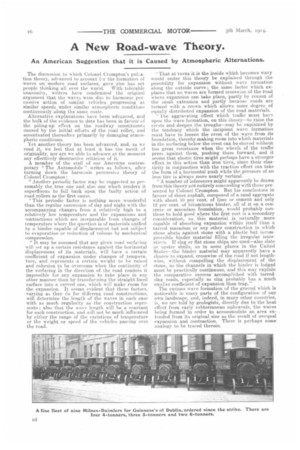A New Road-wave Theory.
Page 16

If you've noticed an error in this article please click here to report it so we can fix it.
An American Suggestion that it is Caused by Atmospheric Alternations.
The discussion to which Colonel Crompton's pulsation theory, advanced to account for the formation of waves on modern road surfaces, gave rise has set people thinking all over the world, With tolerable unanimity, writers have condemned the original argument that the waves were due to harmonic percussive action of similar vehicles progressing at similar speeds under similar atmospheric conditions continuously along the same route.
Alternative explanations have been advanced, and the bulk of the evidence to date has been in favour of the piling-up effect on the roadway constituents caused by the initial efforts of the road roller, and accentuated thereafter primarily by damaging atmospheric conditions.
Yet another theory has been advanced, and, as we read it, we feel that at least it has the merit of originality, nor are we able to advance at the moment any effectively destructive criticism of it.
A member of the staff of our American contemporary " The Automobile " writes as follows, after turning down the harmonic percussive theory of Colonel Crompton: "Another periodic factor may be suggested as presumably the true one and also one which renders it superfluous to fall back upon the faulty action of road rollers as the first cause.
"This periodic factor is nothing more wonderful than the regular succession of day and night with the accompanying changes from a relatively high to a relatively low temperature and the expansions and lontractions which are inseparable from changes of temperature where the question is of materials unified by a binder capable of displacement but not subject to evaporation or reduction of volume by mechanical compression.
" It may be assumed that any given road surfaeing will set up a• certain resistance against the horizontal displacement of its materials, will have a, certain coefficient of expansion under changes of temperature, and represents -a certain weight to be raised and cohesion to be overcome when the continuity of the surfacing in the direction of the road renders it impossible for any expansion to take place in any 'other manner than by transforming the straight-lined surface into a curved one, which will make room for the expansion. It seems evident that these factors, varying as they do for different road constructions, will determine the length of the waves in each case with as much regularity as the construction repre sents; also that the wave length will be a constant for each construction, and will not be much influenced by either the range of the variations of temperature or the weight or speed or the vehicles passing over the road. " That at, turns it is the inside which becomes wavy would under this theory be explained through the possibility for expansion without wave formation along the outside curve ; the same factor which explains that no waves are formed crosswise of the road where expansion can take place, partly by reason of the malt extension and partly because roads are formed with a crown which allows some degree of equally distributed expansion of the road materials. ."Ihe aggravating effect which traffic must have upon the wave formation, on this theory—to raise the crests and deepen the troughs—may he explained by the tendency which the incipient wave formation must have to loosen the crest of the wave from its foundation, thereby making room into which materials in the surfacing below the crest can be shoved without too great resistance when the wheels of the traffic press against them, pushing them forward, and it seems that elastic tires might perhaps have a stronger effect in this action than iron tires, since their elasticity in conjunction with the traction effort can take the form of a horizontal push while the pressure of an iron tire is always more nearly vertical. "A number of inferences might apparently be drawn from this theory not entirely concording with those pre sented by Colonel Crompton. But his conclusions in favour of sheet asphalt, composed of a sand aggregate with about 10 per cent, of lime or cement and only 12 per cent. of bituminous binder, all of it on a, con crete or macadam foundation, would probably continue to hold good _where the first cost is a secondary consideration, as this material is naturally more capable of absorbing expansion within itself than a tarred macadam or any other construction in which stone abuts against stone with a, plastic but hicem pressible binder material filling the irregular interstices. If slag or flat stone chips are used—also slate or oyster shells, as in some places in the United States—the binder material may apparently have a chance to expand, crosswise of the road if not length wise, without compelling the displacement of the stone, as the channels in which the binder is lodged must be practically continuous, and this may explain the comparative success accomplished with tarredslag roads, especially as slag probably has a much smaller coefficient of expansion than trap." The curious wave formation of the ground which is noticeable in many parts of the configuration of our own landscape, and, indeed, in many other countries, is, we are told by geologists, directly due to the heat effect from early subterranean upheavals, the waves being formed in order to accommodate an area extended from its original size as the result of unequal expansion and contraction. There is perhaps some analogy to be traced therein.


























